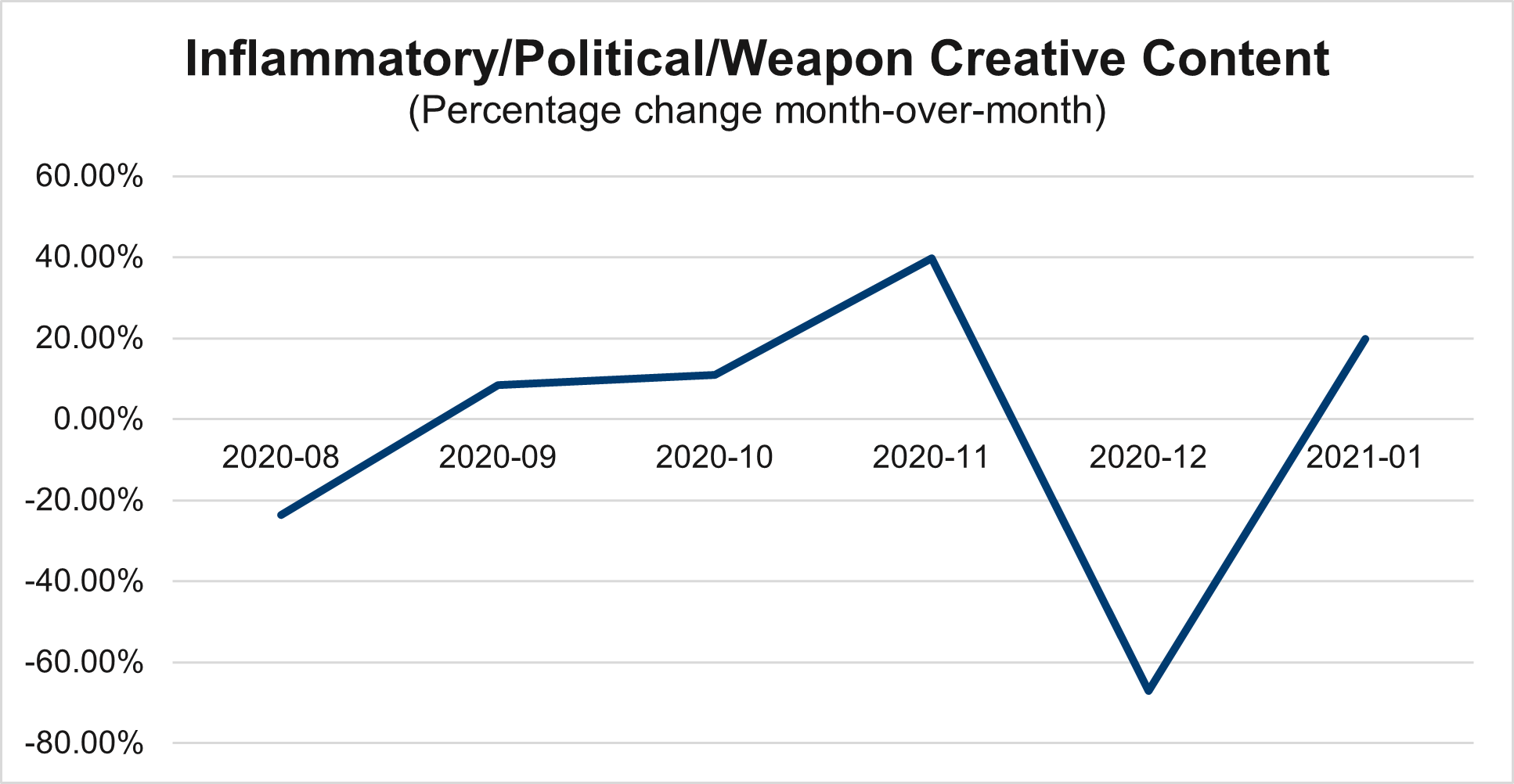January jump in inflammatory creative highlights need for acceptable creative policies.
Key Learnings
- Amount of inflammatory ads doubled in 2020 and continues to rise
- Crises around the globe drove approximately 15% hike in inflammatory creative in January 2021, with incidents on comScore 50 publishers
- Premium publishers often reactive in responding to inflammatory outbreaks, relying on (angry) signals from editorial team (e.g., news rooms) and user
Recommendations
- Ensure you have a creative policy in place that represents views from across the organization—particularly editorial
- Regularly communicate this policy with demand partners to filter out unwanted ad categories.
- Rethink relationships with vendors that continue to serve unwanted ads/content
2021 kicked off with major episodes of political and social unrest around the world. Circulating the web alongside these events are inflammatory, political, and weapons-related creative—with ads appearing on publishers in the comScore 50 [Figure 1]. These incendiary ads further escalate underlying tensions and can cause damage to a publisher’s brand by offending its audience.

Inflammatory Escalation
As noted in our recent report, “The Changing Face of Malvertising,” detection of inflammatory ads almost doubled in 2020, with politically-oriented creative comprising more than 75% of violations each month. From October to November alone—around the time of the US election—inflammatory/political/weapon-oriented creative jumped 40%. December witnessed a decline of more than 60%, which was not surprising. [Figure 2]
However, in January the number spiked back up 15% alongside news of social and political unrest worldwide. In particular, publishers in the comScore Top 50 saw ads for grenade launchers, kevlar (i.e., bulletproof) vests, guns, and knives flood their sites from the programmatic pipes.

What Does Inflammatory Mean Anyway?
In scanning and categorizing creative, The Media Trust stamps an inflammatory label on those that purposefully try to incite or provoke users, typically based on political, social or cultural ideologies. Still, what a publisher or audience considers inflammatory is highly subjective and will differ from publisher to publisher.
To paraphrase Justice Potter Stewart, editorial teams and newsrooms know an inflammatory ad when they see it. The primary bellwether is the receipt of irate emails from offended users. However, with a strong creative policy in place with demand partners, publishers can be more proactive in avoiding inflammatory creative.
There’s a Policy for That
Work with editorial and other teams to understand and document what “inflammatory creative” means for the organization—and for your audience. Include samples of potentially offensive creative and specific items or images that are prohibited (e.g., No depictions of guns, knives, or military-style clothing).
Review and update the policy on a regular basis (at least quarterly) and also when unwanted creatives appear on the site. The norms are constantly changing, so the definition of inflammatory is in flux. It’s tough to expect or prepare for the next insurrection.
Communicate your acceptable creative policy with your demand partners (e.g., SSPs). Show them screenshots of the violating creative running on your pages. If you know the buyer, brand, or category from where these creative stem, share with your partners so they can remedy this as quickly and efficiently as possible.
Recommendations
- Develop an acceptable creative policy with internal partners, e.g., editorial, marketing, legal, or social.
- Ensure demand partners are able to comply with your acceptable creative policy and filter ads that are in violation.
- Track violating ads and their sources. Rethink relationships with demand partners that cannot meet your acceptable creative requests or continue to violate your policy.
- Update your acceptable creative policy on a quarterly basis at minimum; also revisit whenever the team decides a served ad violates said policy.
- Stay vigilant in your lookout for potentially inflammatory creative—especially when tumultuous current events open doors for opportunistic advertisers.

